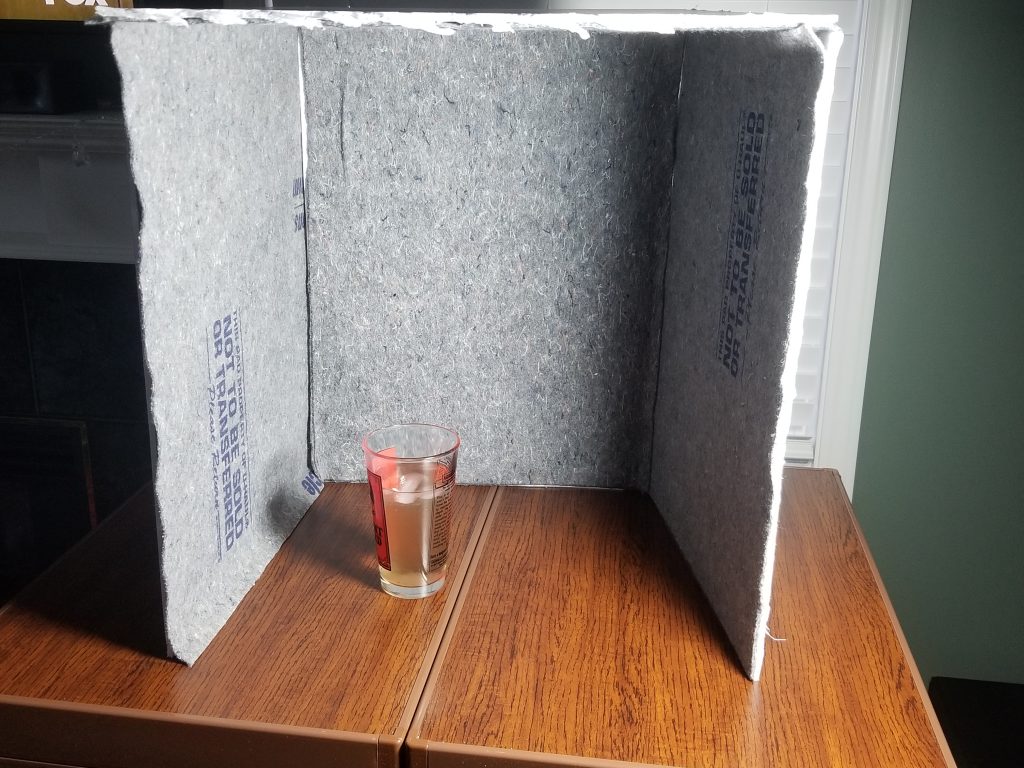
I made a DIY soundbooth for this library course. The instructions said to use proper acoustic foam panels to dampen noise, but I couldn’t find them anywhere within the time needed (the long weekend has cursed me), so I improvised – we’ve got moving blankets instead. I look forward to taking it home and testing it out with my streaming mic.
There are a ton of options for microphones out there, and for library purposes, the advantages and disadvantages start to look like white noise. I own a Blue Yeti for Twitch streaming, and I think it’s a good choice for a stationary microphone in a secondary setting, but some similar models that would probably meet our school needs include the Audio-Technica ATR2100-USB (handheld) and the Blue Snowball (cheaper model than the Yeti). Below are a few recommendations when looking for a mic for school podcasting:
- Find a USB microphone. They are portable (you can take them our of the library), as well as easy to set up for beginners and casual users like myself and (probably) your students and staff – plug it in and go. With an adaptor, you can usually use them with tablets like iPads as well. XLR microphones tend to be higher audio quality, but they require additional (expensive) equipment like a mixer, which may not be easy to use or warranted on a school’s budget. I know that some secondary schools have music/audio production courses that may warrant shelling out for XLR, but it seems like overkill for a general library audience.
- Decide whether you want your mic to sit on a desk, attach to a lapel, or be held in your hand. The Blue Yeti has a built-in stand for sitting on a desk or can be screwed onto a mic stand, but if your students are likely to be recording outside of a classroom (or for video), it might be worth looking into a lapel or handheld mic.
- Decide if you need a special adapter for use with iPad or other tablets. The Blue Yeti can be powered by the Apple Lightning port with a regular Lightning-to-USB adapter, but it will drain the battery faster than normal – there exist camera adapters that allow you to plug in an additional power supply. Other microphones need additional power to work with these lower power devices.
- Price shop and compare features. There are very expensive microphones out there, and you probably don’t need them for library purposes unless audio engineering is something your school is really committing to. I have been talking about the Blue Yeti from experience, but the Blue Snowball is a fairly similar microphone that costs about half as much. There is a difference in performance, to be sure, but the cheaper model may be enough for your library, depending on what you want to do.
Sources
Bradbury, J. (2019, December 16). The Six Best Podcasting Microphones For Classrooms and School Districts. The TeacherCast Educational Network. https://www.teachercast.net/podcasting-microphone-review/.
Facundo. (2021, March 29). USB vs XLR Microphones and why one is better! The Home Recordings. https://thehomerecordings.com/usb-vs-xlr-microphones/.
Harris, M. (2021, May 3). Blue Snowball vs. Yeti: Pros & Cons and Verdict. Leads Rating. https://www.leadsrating.com/microphones/blue-snowball-vs-yeti/.
How to Make Your Own Sound Booth for Better Voice Overs. eLearning Brothers Blog. (2014, October 17). https://blog.elearningbrothers.com/blog/how-to-make-your-own-sound-booth-for-better-voice-overs.
Lubek, T. (2021, May 14). How to connect and use a Blue Yeti to an iPhone or iPad. DIY Video Studio. https://www.diyvideostudio.com/how-to-connect-and-use-a-blue-yeti-to-an-iphone-or-ipad/#What_you_need_to_connect_a_Blue_Yeti_to_an_iPhone.